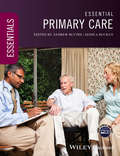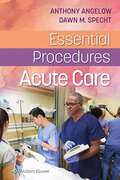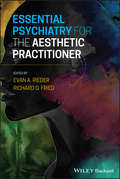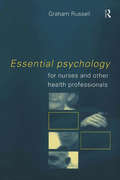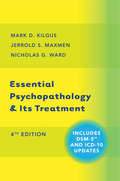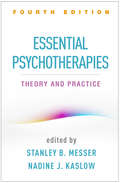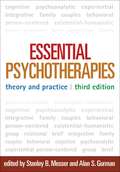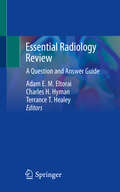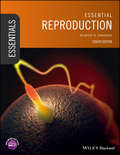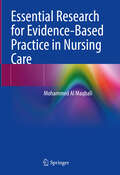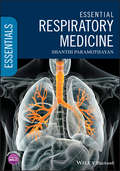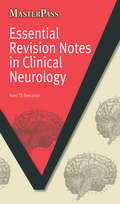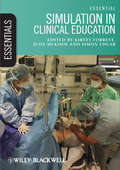- Table View
- List View
Essential Practical Prescribing
by Andrew Stanton Victoria Taylor Amy Hawkins Benedict Lyle Phillips Georgia WoodfieldEssential Practical Prescribing is an important new textbook with a clinical, ward-based focus. It is specifically designed to help new foundation doctors working on the hospital wards and in the community, as well as medical students preparing for the Prescribing Safety Assessment.Using an accessible format, Essential Practical Prescribing demonstrates how to manage common medical conditions, and explains the logic behind each decision. It also emphasises common pitfalls leading to drug errors, and highlights drugs that could cause harm in certain situations. Organised by hospital department, it outlines the correct management of conditions, as well as highlighting the typical trials of a junior doctor.Essential Practical Prescribing:* Contains a range of learning methods within each chapter including: key topics, learning objectives, case studies, DRUGS checklists, 'Top-Tips', advice on guidelines and evidence, and key learning points* Uses patient histories to set the scene and enhance the clinical emphasis* Offers examples of correctly completed drug charts throughout, which are also available online* Is an ideal companion for Prescribing Safety Assessment (PSA) preparation * Includes a companion website at www.wileyessential.com/prescribing featuring MCQs and downloadable DRUGS checklists and drug charts
Essential Primary Care
by Andrew Blythe Jessica BuchanEssential Primary Care aims to provide undergraduate students with a comprehensive overview of the clinical problems encountered in primary care. It covers the structure of primary care in the UK, disease prevention and the management of common and important clinical presentations from infancy to old age. Case studies are used in every chapter to illustrate key learning points. The book provides practical advice on how to consult with patients, make sense of their symptoms, explain things to them, and manage their problems.Essential Primary Care: * Is structured in five sections: - The building blocks of primary care: its structure and connection with secondary care, the consultation, the process of making a diagnosis, prescribing, and ethical issues - Health promotion - Common and important presenting problems in roughly chronological order - Cancer - Death and palliative care* Gives advice on how to phrase questions when consulting with patients and how to present information to patients* Provides advice on how management extends to prescribing - often missing from current textbooks* Contains case studies within each chapter which reflect the variety of primary care and provide top tips and advice for consulting with patients* Supported by a companion website at www.wileyessential.com/primarycare featuring MCQs, EMQs, cases and OSCE checklists
Essential Procedures: Acute Care
by Anthony Angelow Dawn M SpechtStrengthen your advanced practice, acute care nursing skills with Essential Procedures: Acute Care, the indispensable tool for learning how to safely and confidently perform the most common acute care procedures. Organized by body systems, the procedures covered in this book include arterial line insertion, wound closure, and lumbar puncture. A handy, spiral-bound text that lies flat, this ideal resource offers step-by-step direction for acute care nursing students; it is also a handy on-the-unit reference for new acute care nurse practitioners.
Essential Psychiatry
by Robin M. Murray Kenneth S. Kendler Peter McGuffin Simon Wessely David J. Castle Robin M. Murray Kenneth S. Kendler Peter Mcguffin Simon WesselyThis is a major international textbook for psychiatrists and other professionals working in the field of mental healthcare. With contributions from opinion-leaders from around the globe, this book will appeal to those in training as well as experiences professionals seeking a comprehensive and up-to-date overview of effective clinical practice backed by research evidence. The book is divided into cohesive sections moving from coverage of the tools and skills of the trade, through descriptions of the major psychiatric disorders and on to consider special topics and issues surrounding service organization. The final important section provides a comprehensive review of treatments covering all of the major modalities. This new and completely revised edition is the only book to provide this depth and breadth of coverage in an accessible, yet authoritative manner.
Essential Psychiatry for the Aesthetic Practitioner
by Evan A. Rieder Richard FriedAesthetic practice requires an understanding of human psychology, yet professionals across cosmetic medicine and related fields receive no formal training in identifying and managing psychological conditions. Essential Psychiatry for the Aesthetic Practitioner provides concise yet comprehensive guidance on approaching patient assessment, identifying common psychiatric diseases, and managing challenging situations in cosmetic practice. This much-needed guide brings together contributions by dermatologists, plastic surgeons, psychiatrists, psychologists, and other experts to help practitioners understand the role of psychology in cosmetic practice and improve interpersonal relations with their patients. Assuming no previous background knowledge in psychiatry, the text provides cosmetic practitioners of all training and experience levels with clear guidance, real-world advice, and effective psychological tools to assist their practice. Through common clinical scenarios, readers learn to determine if a patient is a good candidate for a cosmetic procedure, enhance the patient experience, deal with difficult personalities in the cosmetic clinic, recognize obsessive compulsive and body dysmorphic disorders, and more. Describes how to use psychologically informed approaches and treatments for aesthetic patients Features easy-to-use psychological tools such as motivational interviewing, progressive muscle relaxation, guided imagery, and acceptance and commitment therapy Includes extensive references and practical tips for understanding the psychological implications of cosmetic treatments Covers cosmetic consultations for female, male, and transgender patients Discusses the history and psychology of beauty as well as the role of cosmetics and cosmeceuticals Emphasizes the importance of screening for common psychological comorbidities Addresses the impact of social media on self-image and its role in a growing crisis in beauty and appearance Highlights the need to develop new guidelines to treat rapidly evolving patient populations Explores how gender fluidity and variations in ethnicity are changing the approaches to aesthetic patients Essential Psychiatry for the Aesthetic Practitioner is required reading for dermatologists, plastic surgeons, cosmetic doctors, dentists, nurses, and physician assistants and all other professionals working in aesthetic medicine.
Essential Psychology for Nurses and Other Health Professionals
by Graham RussellThis text examines the concepts which are fundamental to everyday nursing practice. Understanding how individuals function psychologically in health and illness is vital to providing appropriate care for all patients and clients. Assuming no previous knowledge of the subject, the author explores the basis of individual psychology focusing on personality traits, beliefs systems, body-image and self-esteem. Periods of illness are seen as psychologically demanding events which individuals cope with in different ways. The book considers how we recognize and interpret the signs and symptoms of illness in ourselves, what influences the decision to seek help and whether or not we comply with advice from health professionals. The contribution of psychological factors to physical wellbeing is also examined and the link between psychological theory and patient care is examined throughout the book. With scenarios and questions to help the reader apply the concepts to nursing practice Essential Psychology for Nurses provides an excellent introduction to the subject for pre-registration students and those studying psychological concepts in relation to health care.
Essential Psychopathology & Its Treatment
by Mark D. Kilgus Jerrold S. Maxmen Nicholas G. WardLong considered a leading text on the assessment, diagnosis, and treatmentof psychiatric disorders, this latest revision includes cutting-edge updates inneuroscience, psychopharmacology, and genetics. Geared to resident students inpsychiatry and related disciplines, it makes practical, readable sense of the field.
Essential Psychotherapies, Fourth Edition: Theory and Practice
by Stanley B. Messer Nadine J. KaslowAcclaimed for its clear writing and stellar contributors, this authoritative text is now in a revised and updated fourth edition. The book explains the history, assessment approach, techniques, and research base of each of the 12 most important psychotherapies practiced today, along with its foundational ideas about personality and psychological health and dysfunction. The consistent chapter format facilitates comparison among the various approaches. Every chapter includes engaging clinical vignettes and an extended case example that bring key concepts to life, as well as suggested resources for further learning. New to This Edition *Incorporates important developments in clinical practice and research. *Entirely new chapters on CBT, third-wave CBT, couple therapies, and interpersonal and brief psychodynamic therapies; all other chapters fully updated. *Increased attention to multiple dimensions of diversity, the evidence-based practice movement, psychotherapy integration, and applications to physical health care.
Essential Psychotherapies, Third Edition
by Alan Gurman Stanley MesserThe leading survey text for basic psychotherapy courses, this book offers authoritative, engaging presentations of the 12 most important forms of psychotherapy practiced today. Prominent experts cover traditional treatments as well as influential models that have been developed relatively recently, giving students and practitioners a solid grasp of foundational theories, techniques, and research. Each chapter follows a common set of organizational guidelines; features illustrative vignettes and a full case example; and concludes with readings and resources to guide further study. New to This Edition *Incorporates the latest clinical developments and research. Chapter on "third-wave" behavior therapies. Each chapter has expanded discussions of the role of the therapeutic relationship and the use of evidence-based practices. Concise chapters make the book even more instructor and student friendly.
Essential Public Health
by Padmanabhan Badrinath Jan Yates Stephen GillamHow can society most effectively prevent disease and promote health? That is the challenge addressed by this textbook. Public health is the art and science of preventing disease, prolonging life and promoting health through the organised efforts of society. The 'science' is concerned with making a diagnosis of a population's health problems, establishing their cause and determining effective interventions. The 'art' lies in creatively addressing these problems. Essential Public Health captures both the art and science of the field. This second edition has been fully updated with contemporary examples and includes new chapters on sustainability and change, management and leadership. Examples are taken from health systems throughout the world, giving readers a wider perspective of the challenges faced. This is essential reading for all trainees in health care, social care and related disciplines. An internet companion includes supplementary information and interactive, self-assessment questions to test understanding and aid learning.
Essential Pulse Diagnosis in Chinese Medicine: Mai Jing A-B-C Method
by Jamie HamiltonPulse diagnosis is a notoriously complicated area in Chinese medicine with very few practical or accessible resources available to practitioners to improve their skillset. This clear, didactic manual provides detailed yet user-friendly instructions for a pulse diagnosis method the author has developed called Mai Jing A-B-C, allowing for clinical competency and confidence in pulse diagnosis.Jamie Hamilton draws on pulse methods and techniques found primarily in the 3rd century classic of Chinese medicine, Mai Jing, that have often been overlooked in later centuries. He uses his teaching background to reassess these methods and breaks down incredibly complex concepts into simpler forms to enable learning and immediate application into practice. The method has been honed into six simple steps, each accompanied by detailed case studies to further aid clarity.
Essential Radiological Anatomy for the MRCS
by Stuart Currie Steven Kennish Karen FloodOver recent years the MRCS viva examination has increasingly made use of radiological imaging to facilitate the discussion of anatomy relevant to surgical practice. It is rare for junior doctors to receive adequate exposure to radiology in their day-to-day surgical practice, which makes preparation for this part of the examination difficult. For many, examinations are stressful. The last thing a candidate needs is to be faced with unfamiliar radiological images. This review of surgically relevant radiological imaging aims to prevent initial uncertainties and will allow candidates to discuss relevant anatomy and score valuable points. An invaluable addition to any revision plan, this title also: * highlights typical anatomy viva questions * familiarizes candidates with a range of images of differing modalities (plain film, fluoroscopy, computed tomography and magnetic resonance imaging) * introduces different planes of imaging, enabling candidates to deal with unusual coronal or sagittal views with confidence * gives concise but detailed notes for quick consultation
Essential Radiology Review: A Question and Answer Guide
by Adam E. M. Eltorai Charles H. Hyman Terrance T. HealeyThe book is an on-the-spot reference for residents and medical students seeking diagnostic radiology fast facts. Its question-and-answer format makes it a perfect quick-reference for personal review and studying for board examinations and re-certification. Readers can read the text from cover to cover to gain a general foundation of knowledge that can be built upon through practice or can use choice chapters to review a specific subspecialty before starting a new rotation or joining a new service. With hundreds of high-yield questions and answer items, this resource addresses both general and subspecialty topics and provides accurate, on-the-spot answers. Sections are organized by subspecialty and body area, including chest, abdomen, and trauma, and chapters cover the anatomy, pathophysiology, differential diagnosis, hallmark signs, and image features of major diseases and conditions. Key example images and illustrations enhance the text throughout and provide an ideal, pocket-sized resource for residents and medical students.
Essential Radiology for Sports Medicine
by Philip RobinsonThis highly illustrated, practical book provides a systematic approach to all significant sports injuries. Imaging features are presented along with discussion of the influence of these findings on treatment and image-guided interventions. For each anatomical area, the underlying biomechanical features that produce injury are explored. All imaging modalities are featured with emphasis on MRI, MR arthrography, CT, and ultrasound. A concise guide to sports injuries, this book will help clinicians identify the appropriate imaging techniques and treatments to best serve their patients. This up-to-date resource is an excellent, high-yield resource for radiologists, emergency radiologists, orthopedists, and sports medicine professionals. International experts provide guidance as to how sports injuries occur and how to recognize relevant imaging findings.
Essential Readings in Medicine & Religion
by Gary B. Ferngren Ekaterina N. Lomperis“[A] useful, well-edited anthology of important texts in the history of the intersection of religion and medicine.” —Warren Kinghorn, MD, ThD, Duke University Medical Center and Duke Divinity SchoolGary B. Ferngren and Ekaterina N. Lomperis have gathered a rich collection of annotated primary sources that illustrate the intersection of medicine and religion. Intended as a companion volume to Ferngren’s classic Medicine and Religion, which traces the history of the relationship of medicine to religion in the Western world from the earliest ancient Near Eastern societies to the twenty-first century, this useful and extensive sourcebook places each key document in historical context.Drawing from more than 160 texts, the book explores a number of themes, including concepts of health, the causes and cure of disease, medical ethics, theodicy, beneficence, religious healing, consolation, and death and dying. Each chapter begins with an introduction that furnishes a basic historical setting for the period covered. Modern translations, some of which have been made especially for this volume, are used whenever possible. The texts are numbered sequentially within each chapter and preceded by a short introduction to both the author and the subject.Touching on Mesopotamia, Egypt, Israel, Greece, Rome, the European Middle Ages, Islam, early modern Europe, and the modern era, Essential Readings in Medicine and Religion brings a wide range of sources together to expand on the crucial lessons of Medicine and Religion. This book is a useful introduction for all students of history, divinity, medicine, and health.
Essential Readings in Medicine and Religion
by Gary B. Ferngren Ekaterina N. LomperisAn indispensible collection of sources chronicling the relationship between medicine and religion from ancient to modern times.Gary B. Ferngren and Ekaterina N. Lomperis have gathered a rich collection of annotated primary sources that illustrate the intersection of medicine and religion. Intended as a companion volume to Ferngren’s classic Medicine and Religion, which traces the history of the relationship of medicine to religion in the Western world from the earliest ancient Near Eastern societies to the twenty-first century, this useful and extensive sourcebook places each key document in historical context.Drawing from more than 160 texts, the book explores a number of themes, including concepts of health, the causes and cure of disease, medical ethics, theodicy, beneficence, religious healing, consolation, and death and dying. Each chapter begins with an introduction that furnishes a basic historical setting for the period covered. Modern translations, some of which have been made especially for this volume, are used whenever possible. The texts are numbered sequentially within each chapter and preceded by a short introduction to both the author and the subject.Touching on Mesopotamia, Egypt, Israel, Greece, Rome, the European Middle Ages, Islam, early modern Europe, and the modern era, Essential Readings in Medicine and Religion brings a wide range of sources together to expand on the crucial lessons of Medicine and Religion. This book is a useful introduction for all students of history, divinity, medicine, and health.
Essential Reproduction
by Martin H. JohnsonProviding essential reading for medical, veterinary and biological science students, and students of physiology and trainees in obstetrics and gynaecology, the seventh edition of Essential Reproduction offers an up-to-date account of the fundamentals of reproduction within the context of cutting-edge knowledge and examples of its application. It provides a multidisciplinary approach integrating physiology, genetics, behaviour, anatomy and clinical science, to give thorough coverage of the study of mammalian reproduction.Essential Reproduction is now accompanied by the Wiley E-Text: Powered by VitalSource, and includes:The latest on conceptual, informational and applied aspects of reproductionA new structure offering a more logical approach to study and revisionExpanded further reading suggestions to support researchA companion website at www.essentialreproduction.com features all of the images from the book to download - perfect for instructor and student support.
Essential Reproduction (Essentials)
by Martin H. JohnsonEssential Reproduction provides an accessible account of the fundamentals of reproduction within the context of cutting-edge knowledge and examples of its application. The eighth edition of this internationally best-selling title provides a multidisciplinary approach integrating anatomy, physiology, genetics, behaviour, biochemistry, molecular biology and clinical science, to give thorough coverage of the study of mammalian reproduction. Key features: Contains discussion of the latest on conceptual, informational and applied aspects of reproduction New pedagogical features such as clinical case studies at the end of each chapter Better use of boxed material to improve separation of narrative text from ancillary information Highlighted key words for ease of reference relate to summary of key points Introduction now split into two sections Expanded content in Fetal challenges, and Society and reproduction Substantial rearrangement and updating in Making sperm, Controlling fertility, and Restoring fertility
Essential Research for Evidence-Based Practice in Nursing Care
by Mohammed Al MaqbaliThis textbook delves into nursing research's fundamental concepts, methodologies, and applications, equipping novice and experienced researchers with the knowledge and skills necessary to conduct rigorous and impactful studies. Nursing research is a systematic investigation that aims to generate new knowledge, enhance understanding, and contribute to evidence-based nursing practice. It provides a scientific foundation for decision-making, fosters innovation, and promotes delivering high-quality, patient-centered care. This textbook provides a comprehensive overview of research and evidence-based practice in nursing, catering to both nurses and nursing students. It describes the principles, methods, and processes involved in conducting research, critically appraising literature, and implementing evidence-based practice in nursing care. The main topics addressed include research design and methodology, critical appraisal of research literature, evidence-based practice concepts and processes, translating evidence into practice, disseminating research, and future directions in nursing research. The textbook also highlights the integration of emerging trends and technologies in healthcare research, empowering nurses to stay up-to-date with the latest advancements. Discussing topics like telehealth, big data analytics, and artificial intelligence in the context of evidence-based practice, the book equips nurses to leverage modern tools for improving patient outcomes effectively. Another distinguishing feature of this textbook is its emphasis on real-life case studies and scenarios. Offering practical examples, readers can visualize the application of research findings in different healthcare settings, making the content more engaging and relatable. This approach bridges the gap between theory and practice, promoting a deeper understanding of how evidence-based nursing care positively impacts patient wellbeing. This textbook can help a nursing student embarking on a research journey or an experienced nurse seeking to enhance research skills; it is a valuable resource to guide readers through the exciting and rewarding world of nursing research.
Essential Respiratory Medicine (Essentials)
by Shanthi ParamothayanA succinct yet comprehensive overview of respiratory medicine, written for students and professionals Essential Respiratory Medicine is an indispensable text offering an understanding of respiratory conditions and their clinical management within evidence-based guidelines. Containing information on taking a medical history, performing examinations and investigations, diagnosis and the management of respiratory conditions, this comprehensive text was put together by a noted expert in the field. Written in an accessible manner, Essential Respiratory Medicine contains the foundational science associated with respiratory medicine, a wide-variety of practical procedures, helpful diagrams, and self-assessments designed to enhance understanding of the material presented. The text covers a variety of conditions as well as providing suggestions for engaging with patients at different stages of care. This important resource: Demonstrates an effective approach to patients presenting with common respiratory symptoms Includes a description of all key practical procedures with diagrams Discusses acute management of important respiratory emergencies Covers both acute and chronic disease Contains a companion website containing a range of learning materials, including downloadable management summaries and algorithms, an image bank, videos of patient examination, example respiratory sounds and multiple-choice questions Essential Respiratory Medicine is an essential resource for anyone on a clinical placement, rotation, or training programme in respiratory medicine.
Essential Reviews in Geriatric Psychiatry
by Meera Balasubramaniam Rajesh R. Tampi Deena J. Tampi Juan J. Young Pallavi JoshiThis book critically reviews 75 important published papers that influence the practice of geriatric psychiatry. This book will assist anyone who is interested in the care of older adults with psychiatric disorders. It was written by thought leaders who shape the way geriatric psychiatry is currently practiced in the United States. All the major psychiatric disorders in later life are covered including anxiety disorders, bipolar disorders, depressive disorders, neurocognitive disorders, psychotic disorders, sleep disorders, and substance use disorders. It also reviews important studies on suicides in late life and interventional procedures in geriatric psychiatry like the ECT, and also evaluates the adverse effects of psychotropic medications on older adults with psychiatric disorders. The editors of the book along with input from members of the teaching and training committee of the American Association for Geriatric Psychiatry (AAGP) have chosen 75 published papers from the field of geriatric psychiatry that they believe provides the highest knowledge-yield/impact for practicing clinicians and educators in the field of geriatric mental health. The AAGP is a national association that represents and serves its members and the field of geriatric psychiatry. These 75 papers are critically appraised by the members of AAGP using a standardized format and a summary of these papers and their practical application is provided by these experts. This information can be used by anyone who wants to learn about the field of geriatric psychiatry.
Essential Revision Notes in Clinical Neurology (MasterPass)
by Hani T. BenamerNeurological disorders account for 10% of consultations in primary care and 20% of acute hospital admissions, yet there is good evidence that 'neurophobia' is common among medical students lost in unnecessary detail. This has led to neurology's long-established reputation as a difficult subject. This book is the antidote to neurophobia. It is divided into four sections: Section I introduces the reader to clinical neurology by summarising the basic aspects of a neurological consultation including history and examination; Section II covers neurological signs related to cranial nerves, motor and sensory system and peripheral nerve lesions; Section III comprises the major and common diseases such as headache, epilepsy, stroke, Parkinson's disease and Multiple sclerosis; and Section IV addresses other main neurological problems. The scope of this book is limited to only the most fundamental principles and omits all superfluous detail - ideal for medical students needing a concise introduction to neurology and an overview for revision.
Essential Simulation in Clinical Education
by Judy Mckimm Kirsty Forrest Simon EdgarThis new addition to the popular Essentials series provides a broad, general introduction to the topic of simulation within clinical education. An ideal tool for both teaching and learning, Essential Simulation in Clinical Education provides a theoretical and practical introduction to the subject of simulation, whilst also offering strategies for successful use of simulators within general clinical education and demonstrating best practice throughout.This timely new title provides:The latest information on developments in the field, all supported by an evidence-baseContent written by a global team of expertsDiscussion of policy and strategy initiatives to ground simulation within the healthcare contextPractical examples of cases, including inter-professional learning.A superb companion for those involved in multi-disciplinary healthcare teaching, or interested in health care education practices, Essential Simulation in Clinical Education is the most comprehensive guide to the field currently available.
Essential Skills for Influencing in Healthcare: A Guide on How to Influence Others with Integrity and Success
by Andrew Scowcroft Price AndrewThere is no shortage of issues to be addressed in healthcare, and no shortage of good ideas. What is often lacking is an approach to influencing change that has genuine integrity and trust built in from the start. And integrity is not just a word or a vaguely held value. It has to be demonstrated practically through the way managers and clinicians engage with their colleagues. From the Preface This highly practical book provides clinicians and managers with the knowledge and tools that will enable them to successfully influence their staff and colleagues. Built on the conviction that the way to influence others is through respect and understanding - not threat or manipulation - it promotes an optimistic, confident approach to leadership where trust and respect is fostered.

